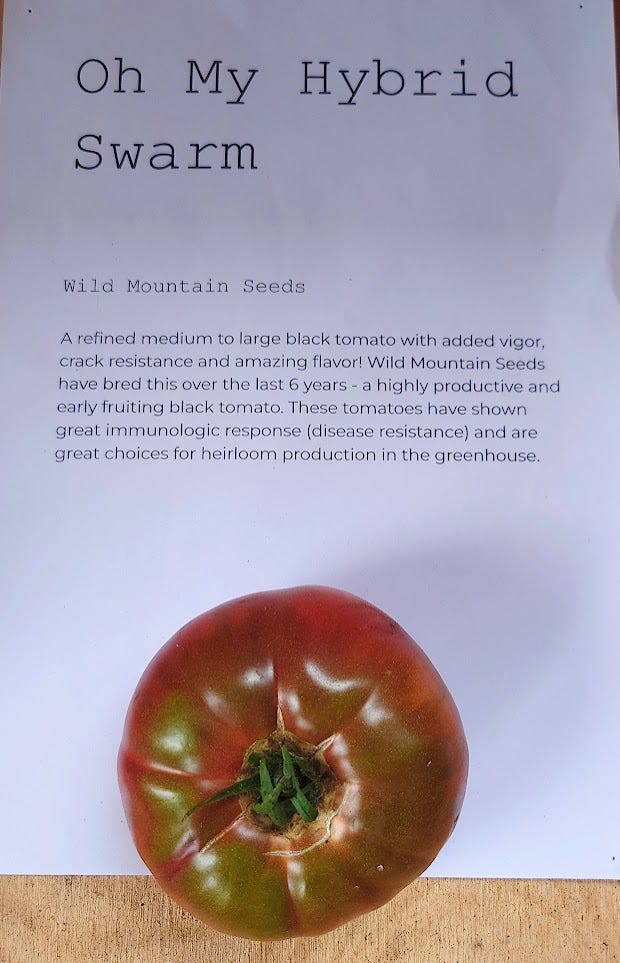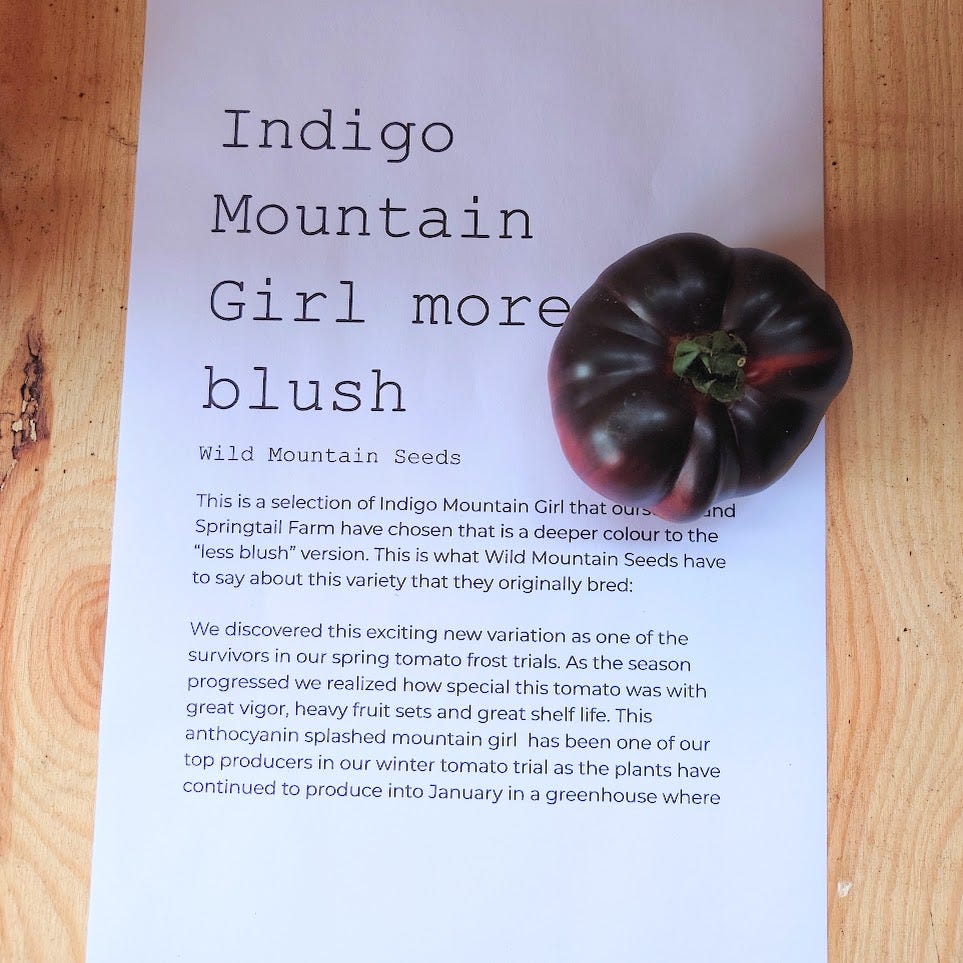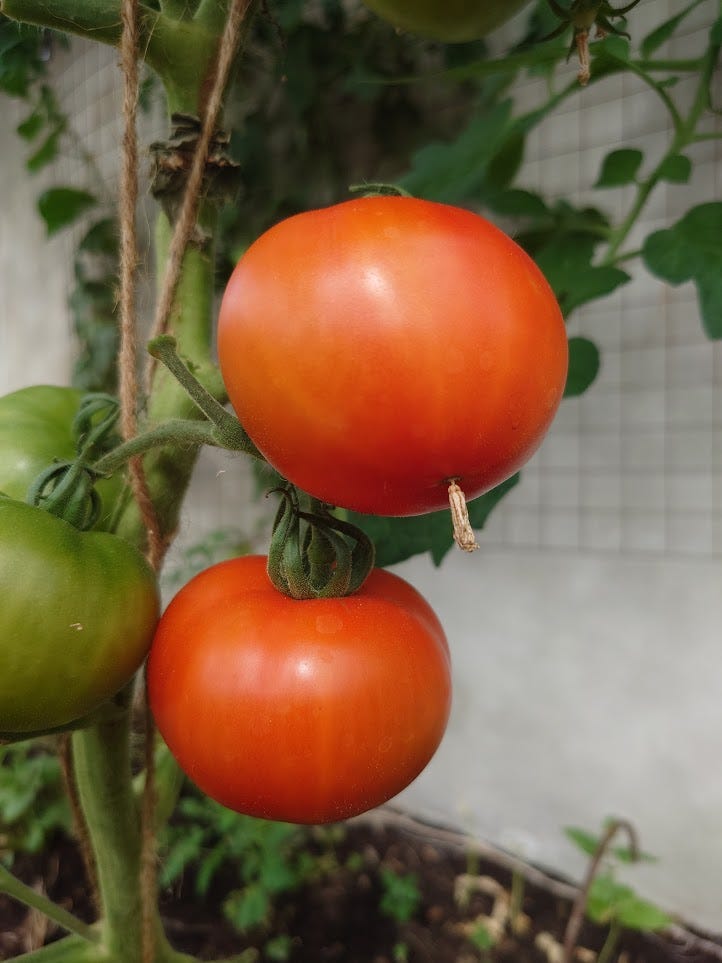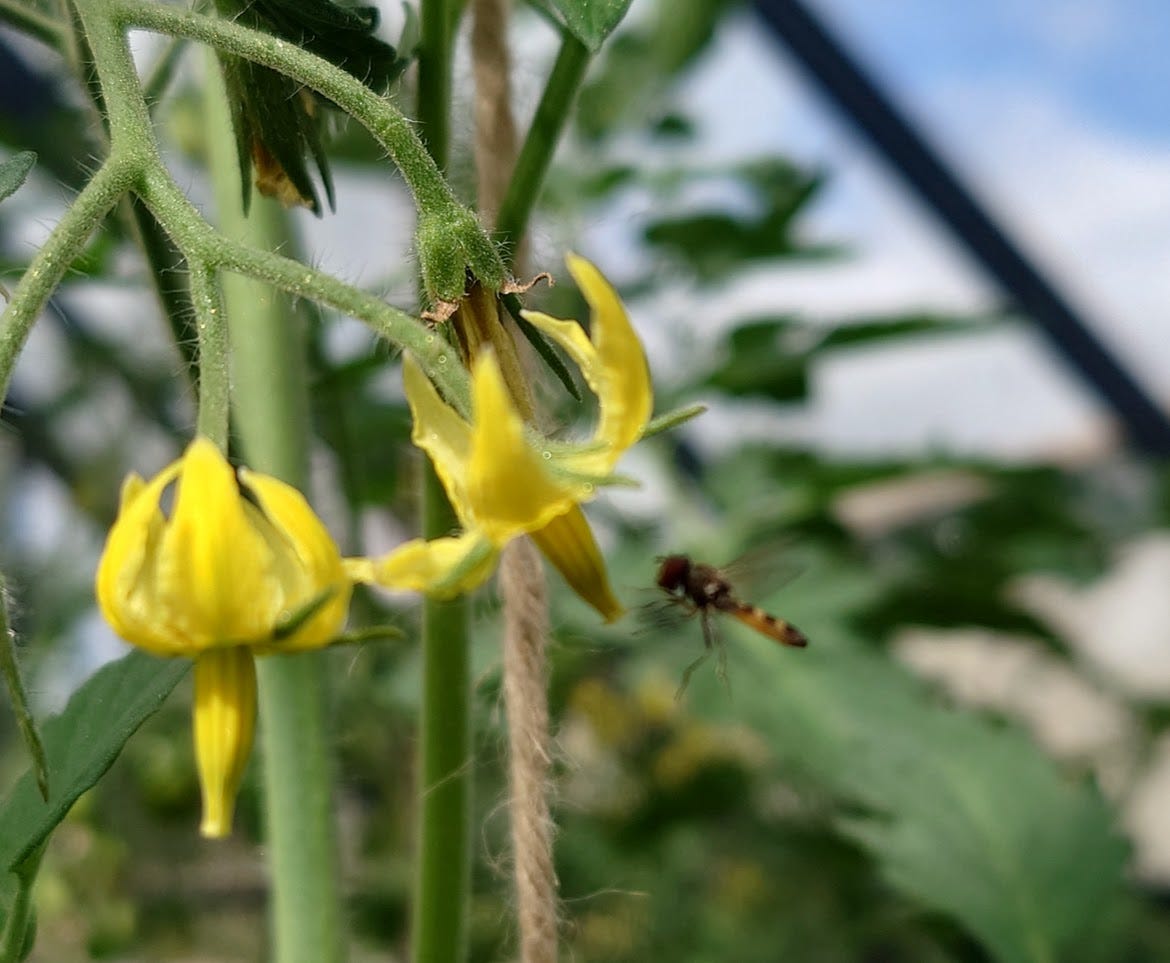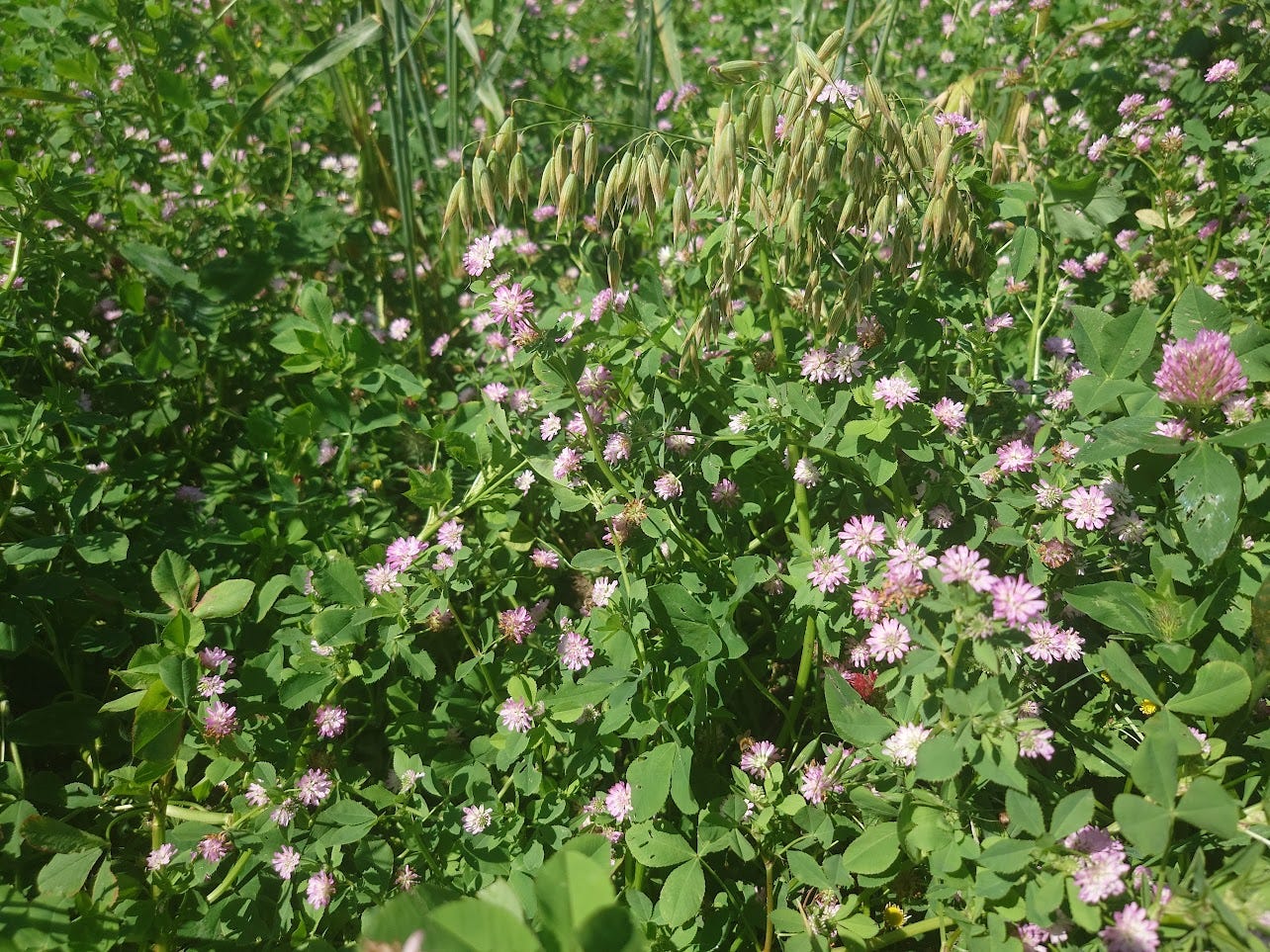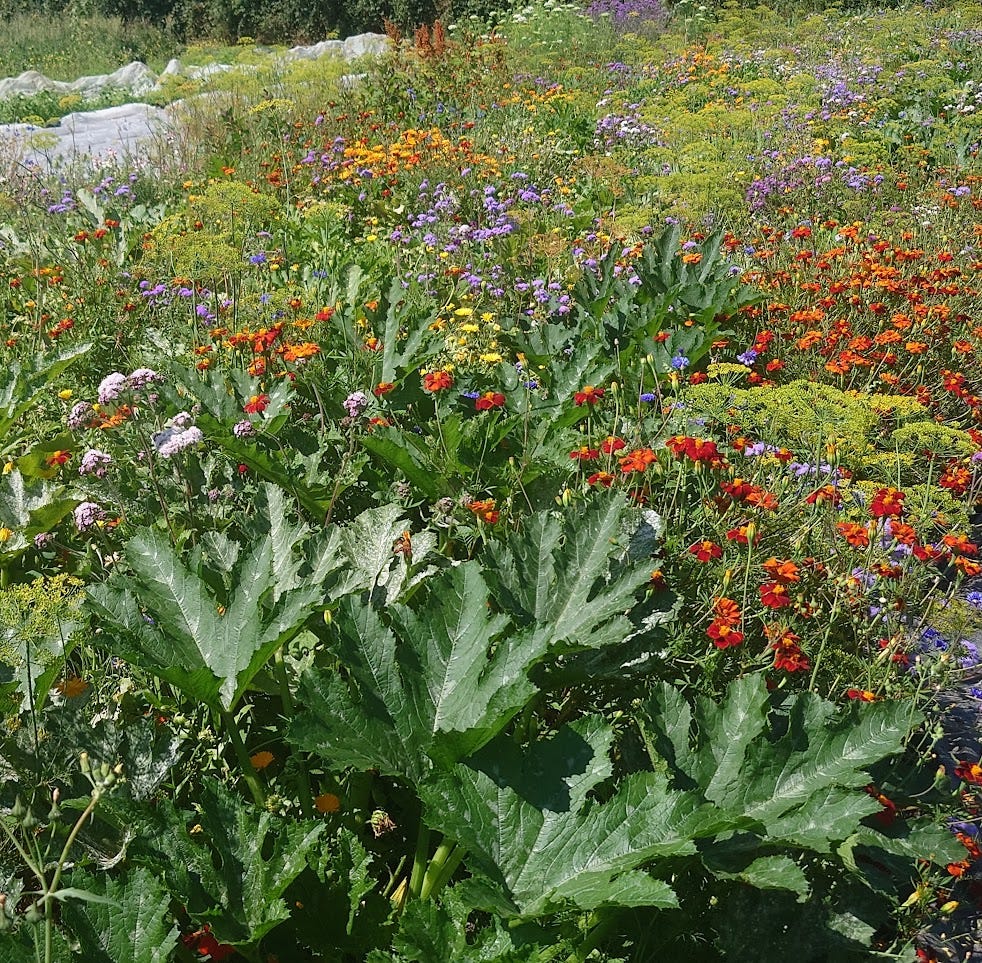Tomato swarms and flocks plus cover crops
Some innovative tomato varieties and how to create you own swarm, flock or population, (and I'll whisper this) tomato blight and some amazing cover crops.
Last Sunday I attended the Tomato Fest at Trill Farm Garden, an organic holding just outside Axminster in Devon run by Ashley Wheeler and Kate Norman. It was a super day, the sun shone and everybody enjoyed walking around the farm garden and eating great food.

Now who has heard of a swarm of tomatoes.…
I went on a tour of the market garden led by Ash and at the start, he introduced some of the varieties grown on the farm and my interest was immediately sparked by the mention of the term swarm – not in the context of insects but of tomatoes.
Swarm is not a word I have associated with tomatoes before, and Ash used it to describe some of the amazing tomatoes he was growing, bred by Casey Piscura of Wild Mountain Seeds, in Colorado USA, including ‘Oh My Hybrid Swarm’.
A swarm is defined as a population of hybrids that contains both parents and their offspring from multiple crosses. There is huge diversity in the swarm or population and many breeders use this diversity as the starting point to create new varieties. Casey Piscura is looking for new varieties that yield well, taste great and have benefits of being cold tolerant or drought resilient - so important in these chaotic climate times. Its not just tomatoes, breeders are doing the same with other crops such as cabbages, corn, melons and squash.
Creating new varieties via the swarm route is not always successful – you have to do many trials to end up with a plant that has the features you want, but there is a potential to throw up some really useful characteristics. The Wild Mountain varieties have many beneficial features. The photo below shows the information about the variety ‘Indigo Mountain Girl’. It’s a variant that survived that spring tomato frost trials plus has great vigour, heavy fruits and longer shelf life. This one can grow into winter in a greenhouse extending the season.
This is a quote from Casey about one of his varieties, Mountain Miracle, seeds of which are on sale via the Experimental Farm Network: “A true ‘Mountain Miracle,’ this large pink heirloom is sure to become a backbone of your heirloom production. Early, productive and crack-resistant, this hybrid swarm is the product of many years of breeding by Wild Mountain Seeds at 6,400’ in Carbondale, Colorado. These seeds perform equally well inside or outside of the greenhouse, and they demonstrate added vigor even when soil temperatures are still cold in the spring. Selection has focused heavily on flavor and I'm certain these genetics will have your customers coming back for these delicious heirlooms year after year. Selection for good immunologic response (disease resistance) and tolerance to light spring frosts are other benefits of these special seeds. The price of these seeds reflects the quality of the plants, which have outperformed other popular and expensive F1 hybrids in head-to-head testing.”
The cost of a pack of seeds is high - $15 in some cases and this is because these seeds are open pollinated – you could buy them and save your own seed, so the initial price is high to reflect the time and money that went into producing these innovative seeds.
Dehybridisation
We are all told that its not worth saving seed from F1 plants, as the resulting plants will not breed true. When you cross two F1 plants, you get an F2 hybrid generation in which the offspring will be variable in appearance, having features from both parents and could be less vigorous or yielding than the F1 parents.
But if you are patient, you can dehybridise an FI hybrid to create your own new variety. This is achieved by allowing F1 plants to cross and produce an F2 generation. Then you choose the best F2 parents, cross pollinate them and use the seed to produce the next generation. This is repeated, and with each generation, the selection process discards plants with less desirable characteristics. After about 7 generations, the desirable phenotype will be seen across most of the offspring, they will be more uniform and they are said to have stable genetics and will breed true.
Ash explained that he liked the characteristics of the popular F1 Sakura tomato - its an early variety compact in habit with high yields of cherry tomatoes with good flavour and its popular with consumers. Ash has saved seed, grown offspring, observed, crossed and saved more seed and generations later he has what he feels is a tomato that is as good as Sakura but is open pollinated, avoiding the need to buy seed each year.
Crimson Crush is another popular F1 variety that has a good yield and taste, as well as being resistant to late blight, which is a bonus if you grow it outside. It is being dehybridised by numerous growers, including a researcher in the Experimental Farm Network, who has dehybridised F1 Crimson Crush into 3 stable strains and is offering seed to volunteers to check how it performs.
I am sure I have some genetically unstable varieties. A few years ago I bought seed of yellow submarine - a small yellow cherry tomato with distinctive potato leaves - I saved seed and the next year I got a long yellow tomato from which I saved seed and this year I have a large orange tomato! The potato leaves help in the identification of the lines.
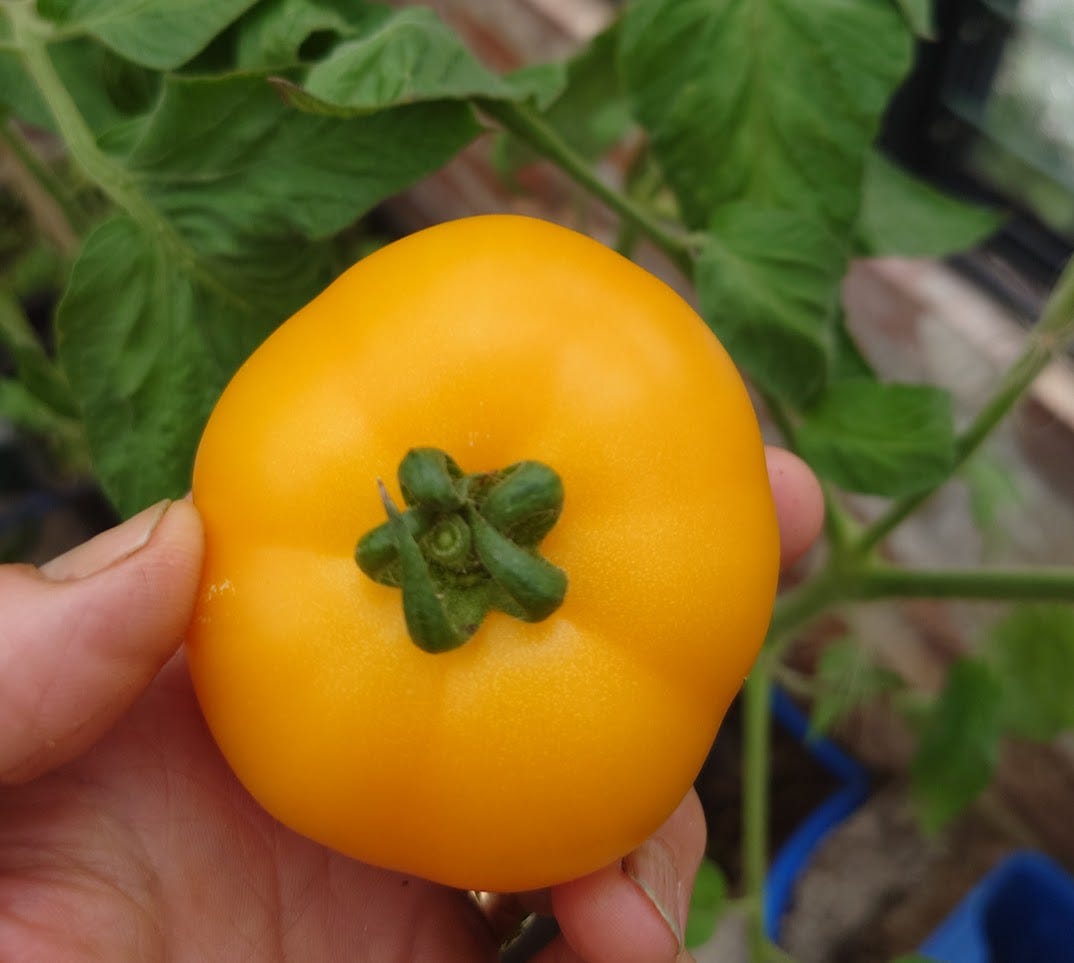
Create your own varieties
There are lots of interesting vegetable trials going on to create new varieties, including the crossing o cabbage varieties to create an adaptive grex, (which is Latin for flock), for different climates. The project information on the Experimental Farm Network states that commercial cabbages tend to be inbred and weak, with the range of varieties being limited, so this project is aiming to mix it up a bit and create more climate tolerant varieties. You can read about it here.
I have been doing something similar with my parsnips, based on populations and you can read more about this and population wheat in this blog from a few years ago.
Creating new varieties and mixing up the gene pool is going to become increasingly important in the years to come, as we will need resilient varieties that can cope with late frost, high temperatures in summer and longer growing seasons that stretch well into autumn. So there is no harm in trying to create a few of your own varieties.
Pollination
I have noticed that pollination hasn’t be great on some of my tomatoes. Tomatoes are self pollinated as the flowers contain both male and female reproductive organs, and can successfully pollinate themselves without help. However, it is quite common, especially in greenhouses, to see flowers falling from healthy plants without having set fruits. I have a couple of cherry varieties at the back of the greenhouse and despite having abundant flowers, there are few fruits.
Why? There are lots of possible reasons. Despite being self pollinated, it helps if there is a bit of wind or insects around to dislodge the pollen. In a greenhouse, both could be lacking, especially at the back. High temperatures can reduce pollination as can high humidity which makes tomato pollen sticky and less easy to move.
Bees are important tomato pollinators. The buzzing of a bee on a tomato flower creates tiny vibrations which are enough to cause pollen to drop off the anthers. Not surprisingly this is called buzz pollination. You can mimic this effect by giving your plants a gentle shake.
Tomato blight
There, I have dared to mention the dreaded word. The high temperatures of late may help reduce incidence this year as temperature and humidity are key. The fungi that cause blight like warm, moist conditions with temperatures between 10-20C and 90+% humidity. The James Hutton Institute in Scotland has a map showing outbreaks of late blight in potatoes which can be a good guide, as tomatoes are susceptible to the same fungal pathogen. There are only a few markers on the map so far, some in Cornwall and Kent near the coast, and the rest to the north of Oxford. There is even an apple app - Blight Map – that you can download. It uses temperature and humidity data to predict blight conditions across the UK.
So, if it cools down and rains over the next few weeks, be vigilant and look out for small brown lesions on leaves and stems which quickly expand. Remove these as quickly as possible so there is little time for the fungi to spore. I drop infected leaves straight into a bag, limiting the spread of spores. When removing infected leaves, I wear rubber gloves that I dip in disinfectant and a cloth soaked in disinfectant to wipe my secateurs between plants so I don’t transfer spores from plant to plant. The infected material can be hot composted (you need 55-60C to kill the spores) or burnt.
Cover crops
There were lots of cover crops at Trill Garden Farm. They are used to protect the soil, add biomass, sequester carbon, boost soil health and attract pollinators and predators. There were large areas of phacelia and buckwheat plus other mixes that included crimson and Persian clover. I hadn’t realised that Persian clover had such a wonderful scent so that’s on the list for next year. Its small pink flowers will work well with phacelia.
The courgette bed was particularly photogenic, the courgettes having been undersown with colourful flowers as you can see here, including Calendula, French marigolds, cornflowers and statice.
So that’s all for this week. Next week I am delving in my favourite group - salvias
Happy gardening
Sally
PS
If you enjoyed this post, please press the like icon at the bottom - it really helps with visibility on Substack.
Talks
Talk 13 September Talk by Sally at Yeo Valley Gardens, Organic September Celebrations, nr Bristol - you can book a ticket via the Yeo Valley website
Talk 21 September Sally is speaking to the Somerset Hardy Perennial Society, West Monkton, nr Taunton
Sally and Kim give talks on a wide range of topics. Please get in touch if you would like to arrange a talk or webinar. You can also arrange group visits to Sally’s experimental garden.





